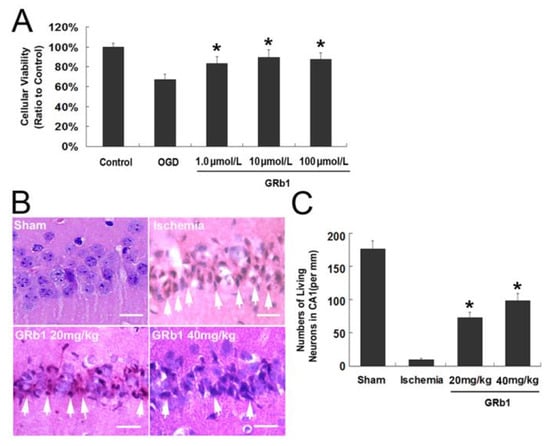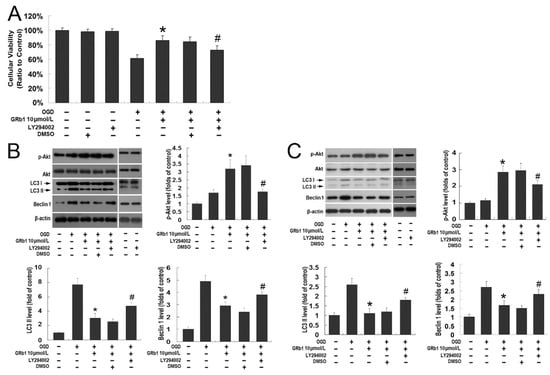In the original publication [], there are some mistakes in Figures 1B and 3B. Because of negligence, the sham image in Figure 1B has been used in our other article published much earlier []. In Figures 3B and 5B. LC3 I and LC3 II bands are similar. The replaced Figure 1 and Figure 3 are provided below. The authors state that the scientific conclusions are unaffected. This correction was approved by the Academic Editor. The original publication has also been updated.

Figure 1.
Protective effect of Ginsenoside Rb1 (GRb1) on both oxygen glucose deprivation (OGD)-induced cell death in SH-SY5Y cells and neuronal death in CA1 region caused by transient global ischemia. (A) MTT assay of cellular viability of SH-SY5Y cells. The reduction in the cellular viability at recovery 24 h following OGD treatment was counteracted by administration of GRb1; (B) Histological images of the CA1 neurons stained with hematoxylin and eosin 40×. The dead neurons indicated by arrows presented condensed polyglonal nuclei and pink cytosols; (C) Statistical analysis of living neurons in the CA1 region. Scale bar = 20 µm. * p < 0.01 versus OGD group. Each experiment was performed four times.

Figure 3.
The PI3K/Akt pathway contributed to the protection of ginsenoside Rb1 against lethal autophagy caused by OGD. (A) MTT assay of cellular viability in SH-SY5Y cells. Although 10.0 µmol/L GRb1 significantly inhibited OGD-induced cell death in SH-SY5Y cells at 24 h recovery, pretreatment with PI3K inhibitor LY294002 prior to GRb1 reversed the protection of GRb1. DMSO, the solvent of LY294002, did not show any effect on the protection of GRb1; (B) Images of Western blotting and statistics of optical densities of immunoblots at 12 h recovery; (C) Images of Western blotting and statistics of optical densities of immunoblots at 24 h recovery. The elevated protein level of phosphor-Akt at Ser473 and the reduced expression of Beclin1 and LC3II caused by GRb1 were all counteracted by pretreatment with PI3K inhibitor LY294002 either at 12 or 24 h recovery. * p < 0.01 versus OGD group; # p < 0.01 versus GRb1 group. Each experiment was performed four times.
References
- Luo, T.; Liu, G.; Ma, H.; Lu, B.; Xu, H.; Wang, Y.; Wu, J.; Ge, P.; Liang, J. Inhibition of Autophagy via Activation of PI3K/Akt Pathway Contributes to the Protection of Ginsenoside Rb1 against Neuronal Death Caused by Ischemic Insults. Int. J. Mol. Sci. 2014, 15, 15426–15442. [Google Scholar] [CrossRef] [PubMed]
- Feng, C.; Luo, T.; Qi, L.; Wang, B.; Luo, Y.; Ge, P. Ischemic Postconditioning Alleviates Neuronal Injury Caused by Relief of Carotid Stenosis in a Rat Model of Cerebral Hypoperfusion. Int. J. Mol. Sci. 2012, 13, 13338–13351. [Google Scholar] [CrossRef] [PubMed]
Disclaimer/Publisher’s Note: The statements, opinions and data contained in all publications are solely those of the individual author(s) and contributor(s) and not of MDPI and/or the editor(s). MDPI and/or the editor(s) disclaim responsibility for any injury to people or property resulting from any ideas, methods, instructions or products referred to in the content. |
© 2025 by the authors. Licensee MDPI, Basel, Switzerland. This article is an open access article distributed under the terms and conditions of the Creative Commons Attribution (CC BY) license (https://creativecommons.org/licenses/by/4.0/).